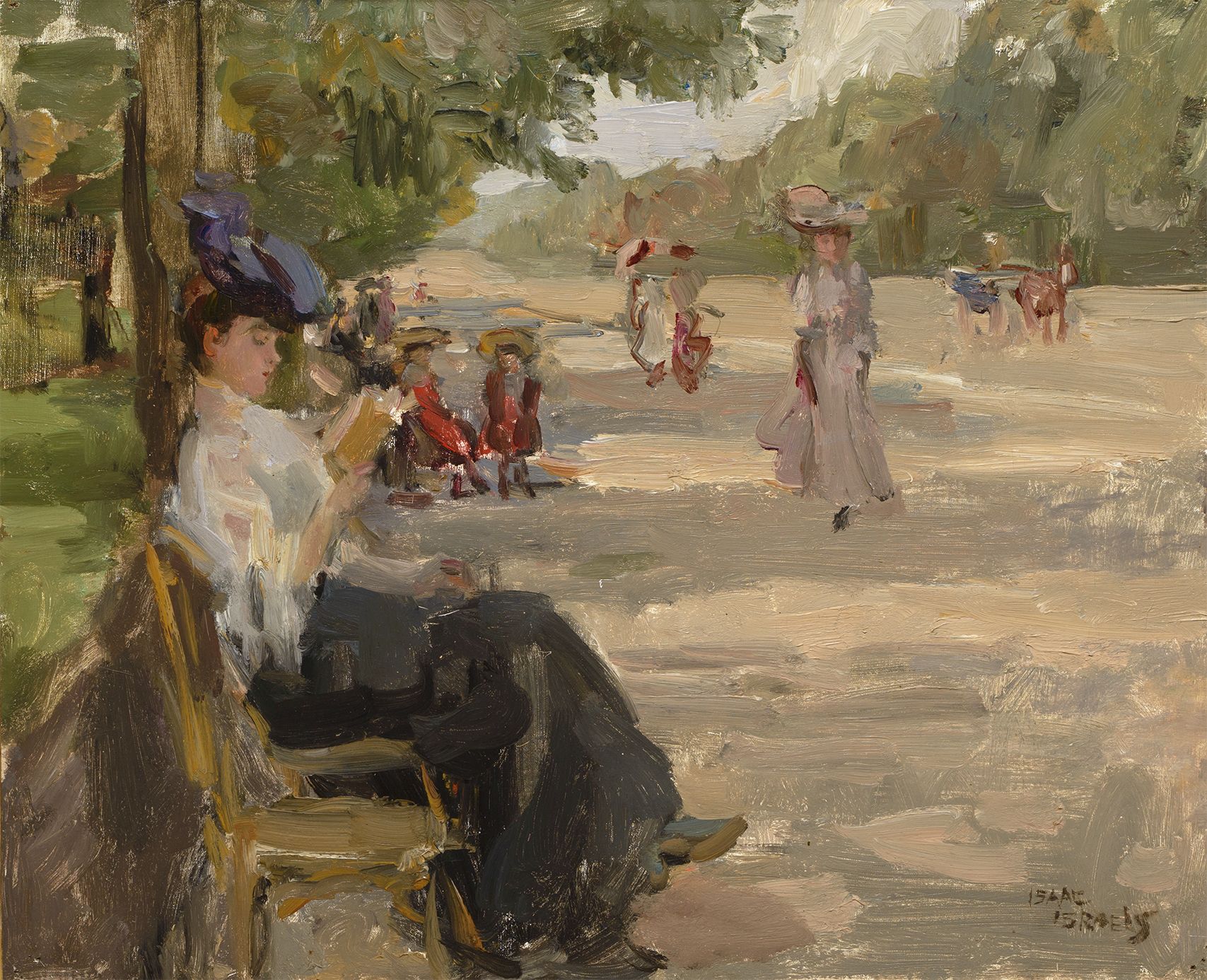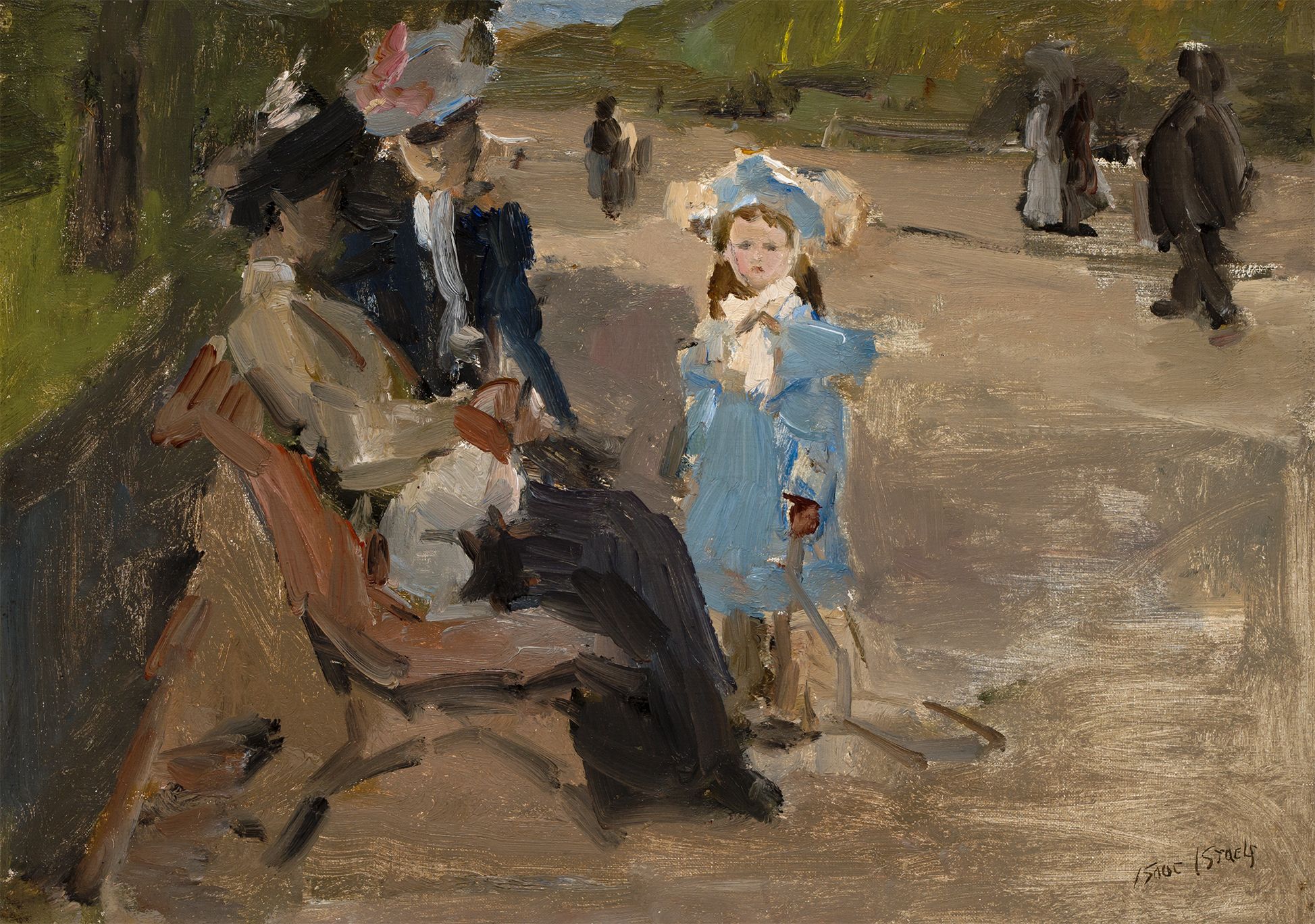I.L. (ISAAC) ISRAELS 1865 Amsterdam - 1934 The Hague Reading in the Bois de Boulogne, Paris
Oil / Canvas: 38 x 46 cm
- This artwork can be viewed in our gallery
- Call us for more information: +31 26 361 1876
- World wide shipping available
Details
Isaac Israels was especially a painter of life in the big city. Paris, around 1900, the cultural capital of Europe, played a major role in his life. Seeking beauty in day-to-day reality was Israels’ mission and he became an expert in capturing an essence by a few broad brushstrokes. Our painting is a climax of Israels’ ripe impressionist style. We see a young lady reading a book on a bench in the shade of the trees on one of the broad lanes of the big city park Bois de Boulogne. The broad brushstrokes, combined with a subtle use of colours, are characteristic for Israels’ Parisian work. His ostensibly nonchalant style contributes to the relaxed atmosphere of a day in the park.
Width: 46 cm
Artwork is included in the digital “Catalogue Raisonné” by the 'Rijksbureau voor Kunsthistorische Documentatie (RKD)' in The Hague
Over I.L. (ISAAC) ISRAELS
Isaac Israels was the only son of the painter Jozef Israels. The family moved from Amsterdam to The Hague in 1871. Isaac also received his training at the academy at the same time as George Breitner, Floris Verster and Marius Bauer, among others. He was a promising artist from an early age and won awards for his paintings. In the '80s, Isaac specialized in military subjects, an interest he shared with Breitner and Verster. Despite this promising start, he felt his education was not yet complete and went to Amsterdam, where he was accepted into the circle of the Tachtigers. Turbulent city life became the common thread through his work. Between 1887 and 1894, things were quiet around him: few paintings are known from this period. Starting in the mid-1890s, Israels went back to The Hague in the summers where he and his father would paint at the beach. They rented a villa in Scheveningen. His paintings of donkey-riding children were crowd pleasers and are still extremely popular. Israels joked that selling a painting was "the Highest of Arts." His donkey-riding children were eagerly purchased at high prices, and can be considered highlights of his oeuvre for just that reason. Isaac Israels was not only the virtuoso painter of modern (city) life, he was also a gifted portraitist. Especially in the last phase of his life, he commissioned portraits of important Dutchmen. Even in this genre, women remained his favorite subject. All his life he preferred to draw and paint maids, Amsterdam street girls, telephone operators, mannequins in department stores and nude models. His portraits of women are also highlights of his oeuvre, such as of the spy Mata Hari, the first female doctor Aletta Jacobs and the actress Fie Carelsen. Isaac Israels was accustomed to giving a quick characterization of his models. A crisp characterization had to appear on the canvas at once. As such, his best paintings are vivid, spontaneous and struck just right. 'I had an attack of patriotism the other day when I looked out my window to my surprise. Surely the Hollandsche is to my mind the most beautiful thing there is,' Isaac Israels on his way to London from Hamburg to the painter Willem Witsen. That did not prevent him from traveling up and down the continent. Israels always loved to travel. Even as a child, he went to Paris with his parents every year. He made trips to Italy, Spain and North Africa, Switzerland, Spain and Scandinavia to draw and paint. In the 1920s, he even spent some time in the Dutch East Indies. Starting in 1903, Israels had his own studio in Paris, where he found his favorite subjects among fashionable Parisians and was able to immerse himself in the modern art on display there. In the spring of 1913, he traded that city for London, where he had his own studio for a time. Despite all the travel and all the impressions, Israels always remained himself. He was a neighbor to Picasso in Paris, went into town with Kees van Dongen, admired the symbolist Odilon Redon and for a time had one of Vincent van Gogh's Sunflowers on his wall. All these modern impressions, however, did not allow him to be diverted from his laboriously developed path. After his Amsterdam years, his palette became lighter and his subjects more mundane, but he stuck to his virtuoso impressionist style until his death. In 1923 he settled permanently on Koninginnegracht in The Hague, where he had left his father's studio vacant until long after his death.











